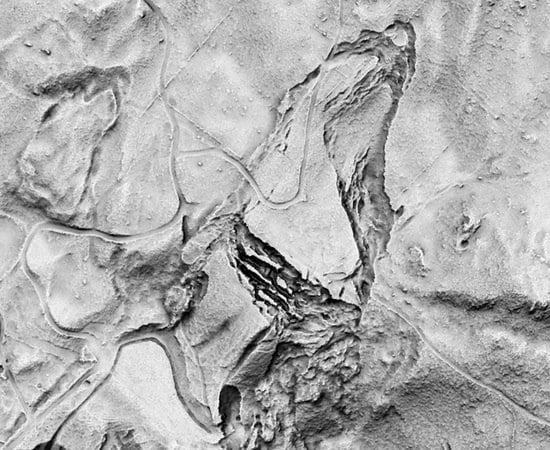VAT Method for Visualization of Mass Movement Features: An Alternative to Hillshaded DEM
Abstract
1. Introduction
2. Materials and Methods
2.1. Geological Setting
2.2. Studied Locations
2.2.1. Slano Blato Landslide
2.2.2. Breccia Block of the Podboršt Landslide
2.2.3. Marjančna Ravna Landslide
2.2.4. Strešnice Carbonate Block
2.2.5. Školj of St. Pavel Breccia Block
2.3. VAT Method
- The results are comparable across diverse geographical areas;
- It does not introduce artificial artifacts;
- The visual extent and shape of recorded features are not altered;
- It shows small topographic features in the same way irrespective of their orientation or shape, allowing us to judge their height and amplitude;
- The calculation is fast and does not slow down the mapping process.
3. Results and Discussion
3.1. Locations
3.1.1. Slano Blato Landslide
3.1.2. Breccia Block of the Podboršt Landslide
3.1.3. Marjančna Ravna Landslide
3.1.4. Strešnice Carbonate Block
3.1.5. Breccia Block of Školj of St. Pavel
3.2. Comparison of the Methods
4. Conclusions
Author Contributions
Funding
Acknowledgments
Conflicts of Interest
References
- Van Den Eeckhaut, M.; Poesen, J.; Verstraeten, G.; Vanacker, V.; Moeyersons, J.; Nyssen, J.; van Beek, L.P.H. The effectiveness of hillshade maps and expert knowledge in mapping old deep-seated landslides. Geomorphology 2005, 67, 351–363. [Google Scholar] [CrossRef]
- Yokoyama, R.; Shlrasawa, M.; Pike, R.J. Visualizing topography by openness: A new application of image processing to digital elevation models. Photogramm. Eng. Remote Sens. 2002, 68, 251–266. [Google Scholar]
- Zakšek, K.; Oštir, K.; Kokalj, Ž. Sky-view factor as a relief visualization technique. Remote Sens. 2011, 3, 398–415. [Google Scholar] [CrossRef]
- Jemec Auflič, M.; Jež, J.; Popit, T.; Košir, A.; Maček, M.; Logar, J.; Petkovšek, A.; Mikoš, M.; Calligaris, C.; Boccali, C.; et al. The variety of landslide forms in Slovenia and its immediate NW surroundings. Landslides 2017, 14, 1537–1546. [Google Scholar] [CrossRef]
- Popit, T.; Jež, J.; Verbovšek, T. Mass movement processes of Quaternary deposits in the Vipava Valley, SW Slovenia. In Advancing Culture of Living with Landslides; Mikoš, M., Casagli, N., Yueping, Y., Sassa, K., Eds.; Springer: Cham, Switzerland, 2017; Volume 4, pp. 571–580. [Google Scholar] [CrossRef]
- Verbovšek, T.; Košir, A.; Teran, M.; Zajc, M.; Popit, T. Volume determination of the Selo landslide complex (SW Slovenia): Integrating field mapping, ground penetrating radar and GIS approaches. Landslides 2017, 14, 1265–1274. [Google Scholar] [CrossRef]
- Verbovšek, T.; Popit, T. GIS-assisted classification of litho-geomorphological units using Maximum Likelihood Classification, Vipava Valley, SW Slovenia. Landslides 2018, 15, 1415–1424. [Google Scholar] [CrossRef]
- Placer, L.; Jež, J.; Atanackov, J. Structural aspect of the Slano blato landslide (Slovenia). Geologija 2008, 51, 229–234. [Google Scholar] [CrossRef]
- Jež, J. Reasons and mechanism for soil sliding processes in the Rebrnice area, Vipava Valley, SW Slovenia. Geologija 2007, 50, 55–63. [Google Scholar] [CrossRef]
- Popit, T.; Jernej, J.; Košir, A.; Fifer Bizjak, K.; Ribičič, M. Kvartarni pobočni sedimenti severnega in vzhodnega roba Vipavske doline (Quaternary slope sediments of northern and eastern border of the Vipava Valley). In Abstracts and Field Trips, Proceedings of the 4th Slovenian Geological Congress, Ankaran, Slovenia, 8–10 October 2014; Rožič, B., Verbovšek, T., Vrabec, M., Rožič, B., Verbovšek, T., Vrabec, M., Eds.; Faculty of Natural Sciences and Engineering: Ljubljana, Slovenia, 2014; pp. 98–103. [Google Scholar]
- Kocjančič, M.; Popit, T.; Verbovšek, T. Gravitational sliding of the carbonate megablocks in the Vipava Valley, SW Slovenia. Acta Geogr. Slov. 2019, 49, 7–22. [Google Scholar] [CrossRef]
- Buser, S. Basic Geological Map of SFRJ 1:100 000. Guide for Sheet Gorica; Federal Geological Survey: Belgrade, Yugoslavia, 1973; p. 50. [Google Scholar]
- Buser, S. Basic Geological Map of SFR Yugoslavia 1:100.000, Gorica Sheet; Federal Geological Survey: Belgrade, Yugoslavia, 1968. [Google Scholar]
- Placer, L. Geologic structure of south-western Slovenia. Geologija 1981, 24, 27–60. [Google Scholar]
- Janež, J.; Čar, J.; Habič, P.; Podobnik, R. Vodno Bogastvo Visokega Krasa: Ranljivost Kraške Podzemne vode Banjščic, Trnovskega Gozda, Nanosa in Hrušice; Geologija D.o.o: Idrija, Slovenia, 1997; p. 167. [Google Scholar]
- Popit, T.; Rožič, B.; Šmuc, A.; Kokalj, Ž.; Verbovšek, T.; Košir, A. A lidar, GIS and basic spatial statistic application for the study of ravine and palaeo-ravine evolution in the upper Vipava Valley, SW Slovenia. Geomorphology 2014, 204, 638–645. [Google Scholar] [CrossRef]
- Logar, J.; Fifer Bizjak, K.; Kočevar, M.; Mikoš, M.; Ribičič, M.; Majes, B. History and present state of the Slano blato landslide. Nat. Hazards Earth Syst. Sci. 2005, 5, 447–457. [Google Scholar] [CrossRef]
- Fifer Bizjak, K.; Zupančič-Valant, A. Site and laboratory investigation of the Slano blato landslide. Eng. Geol. 2009, 105, 171–185. [Google Scholar] [CrossRef]
- Kočevar, M.; Ribičič, M. Geological, hydrogeological and geomechanical investigation of Slano blato landslide. Geologija 2002, 45, 427–432. [Google Scholar] [CrossRef]
- Mikoš, M.; Petkovšek, A.; Majes, B. Mechanisms of landslides in over-consolidated clays and flysch. Activity scale and targeted region: National. Landslides 2009, 6, 367–371. [Google Scholar] [CrossRef]
- Maček, M.; Majes, B.; Petkovšek, A. Lessons learned from 6 years of suction monitoring of the Slano blato landslide. Riv. Ital. Geotech. 2016, 1, 21–33. [Google Scholar]
- Petkovšek, A.; Maček, M.; Mikoš, M.; Majes, B. Mechanisms of active landslides in Flysch. In Landslides Global Risk Preparedness; Sassa, K., Rouhban, B., Briceno, S., McSaveney, M., He, B., Eds.; Springer: Berlin/Heidelberg, Germany, 2013; pp. 149–165. [Google Scholar]
- Kokalj, Ž.; Somrak, M. Why Not a Single Image? Combining Visualizations to Facilitate Fieldwork and On-Screen Mapping. Remote Sens. 2019, 11, 747. [Google Scholar] [CrossRef]
- Canuto, M.A.; Estrada-Belli, F.; Garrison, T.G.; Houston, S.D.; Acuña, M.J.; Kováč, M.; Marken, D.; Nondédéo, P.; Auld-Thomas, L.; Castanet, C.; et al. Ancient lowland Maya complexity as revealed by airborne laser scanning of northern Guatemala. Science 2018, 361, eaau0137. [Google Scholar] [CrossRef]
- Chiba, T.; Kaneta, S.; Suzuki, Y. Red Relief Image Map: New Visualization Method for Three Dimension Data. ISPRS Arch. 2008, 37, 1071–1076. [Google Scholar]
- Görüm, T. Tectonic, topographic and rock-type influences on large landslides at the northern margin of the Anatolian Plateau. Landslides 2019, 16, 333–346. [Google Scholar] [CrossRef]
- Asia Air Survey Patents for RRIM. Available online: https://www.rrim.jp/en/patent/ (accessed on 25 April 2019).
- Lo, C.-M.; Lee, C.-F.; Keck, J. Application of sky view factor technique to the interpretation and reactivation assessment of landslide activity. Environ. Earth Sci. 2017, 76, 375. [Google Scholar] [CrossRef]
- Chudý, F.; Slámová, M.; Tomaštík, J.; Prokešová, R.; Mokroš, M. Identification of Micro-Scale Landforms of Landslides Using Precise Digital Elevation Models. Geosciences 2019, 9, 117. [Google Scholar] [CrossRef]
- Kokalj, Ž.; Zakšek, K.; Oštir, K.; Pehani, P.; Čotar, K.; Somrak, M. Relief Visualization Toolbox; ZRC SAZU: Ljubljana, Slovenia, 2019. [Google Scholar]
- Popit, T. Origin of planation surfaces in the hinterland of Šumljak sedimentary bodies in Rebrnice (Upper Vipava Valley, SW Slovenia). Geologija 2017, 60, 297–307. [Google Scholar] [CrossRef]
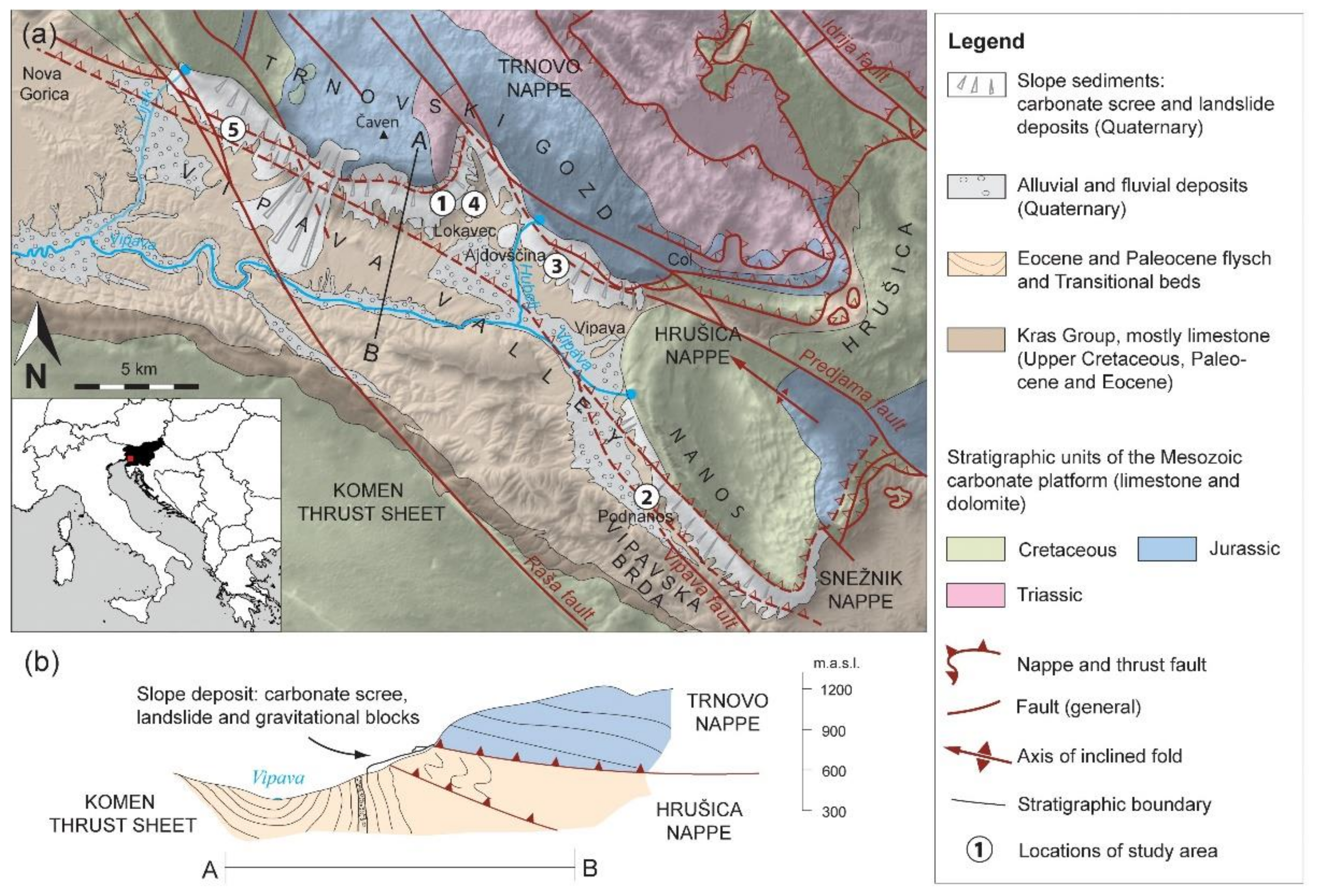

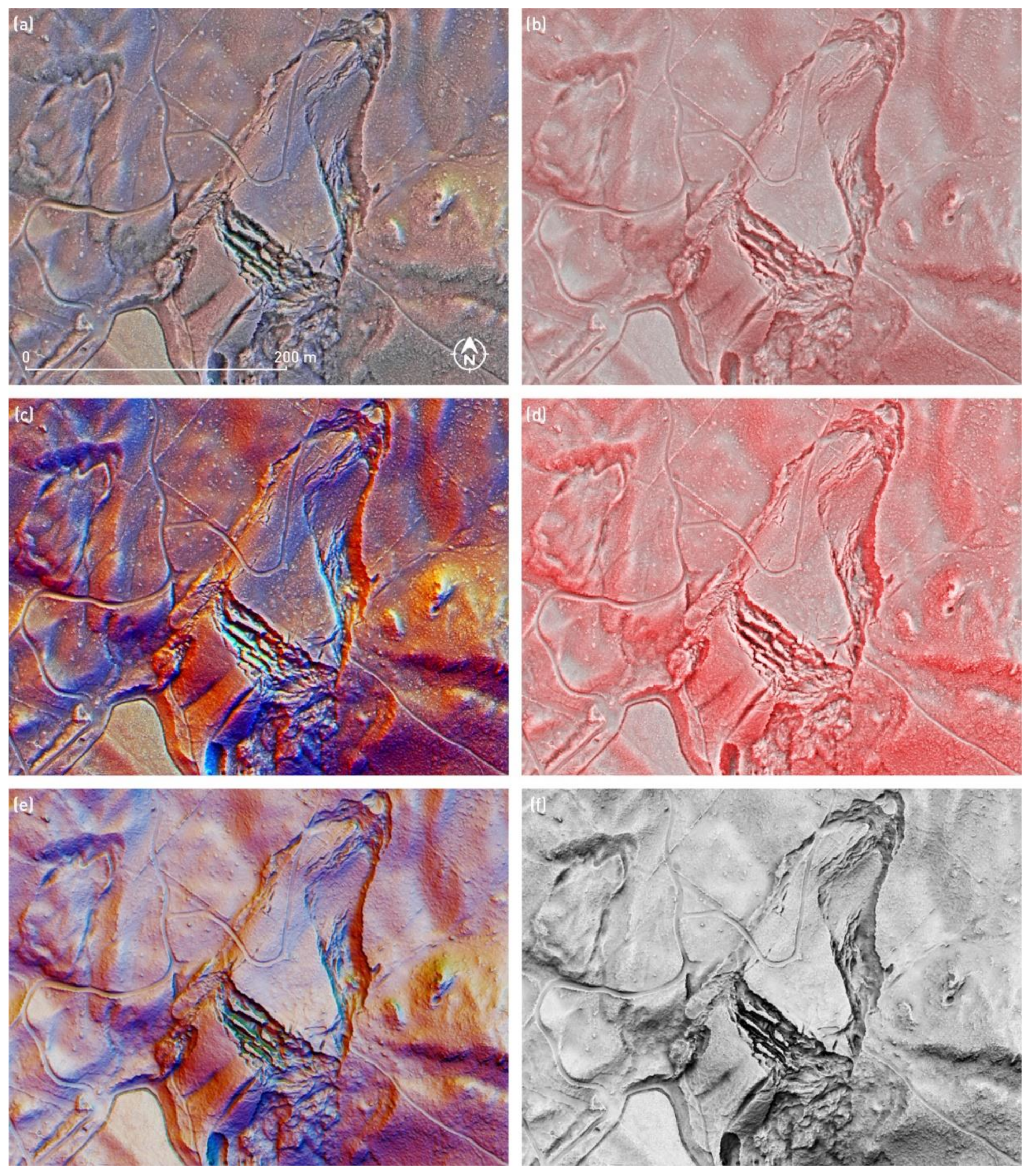
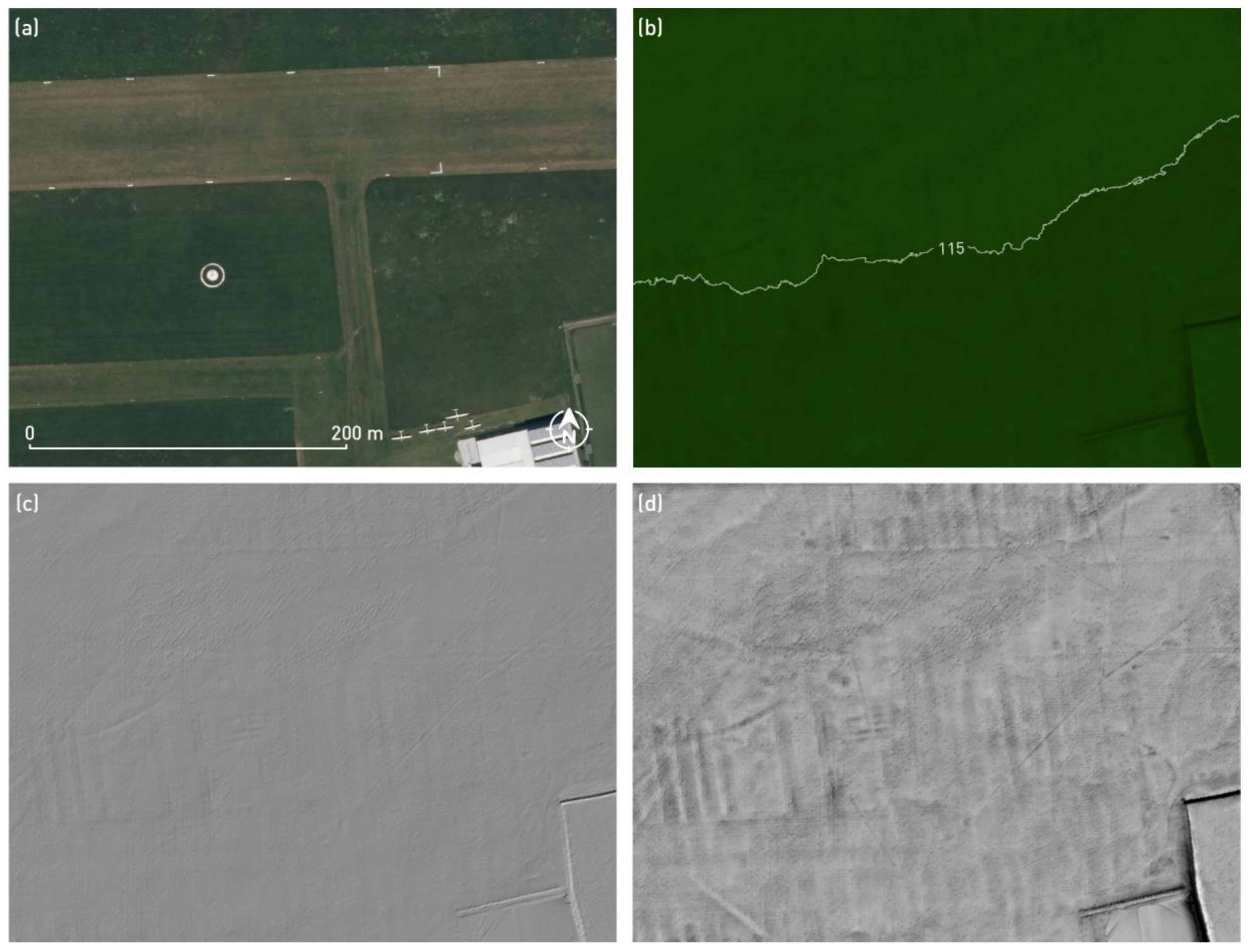
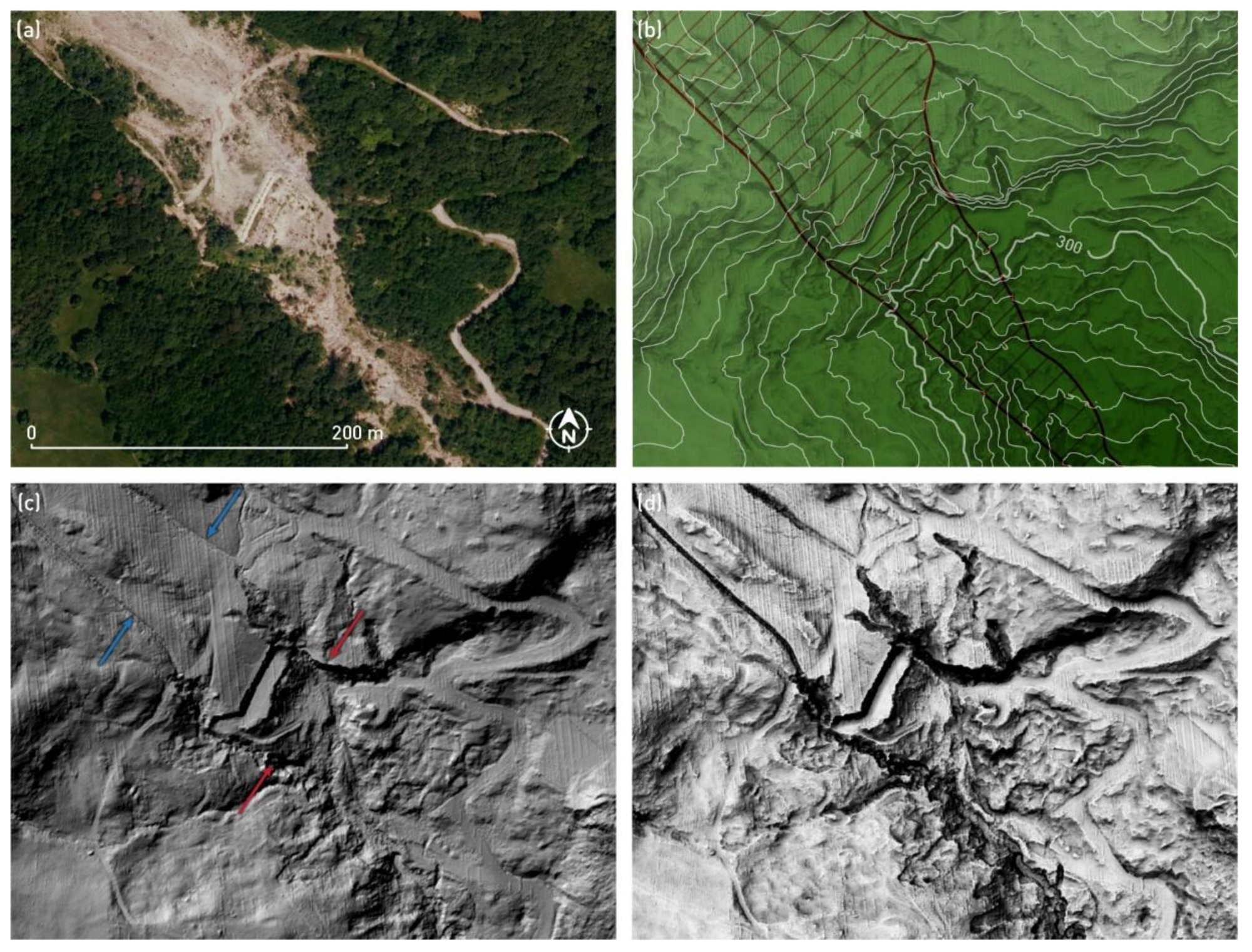
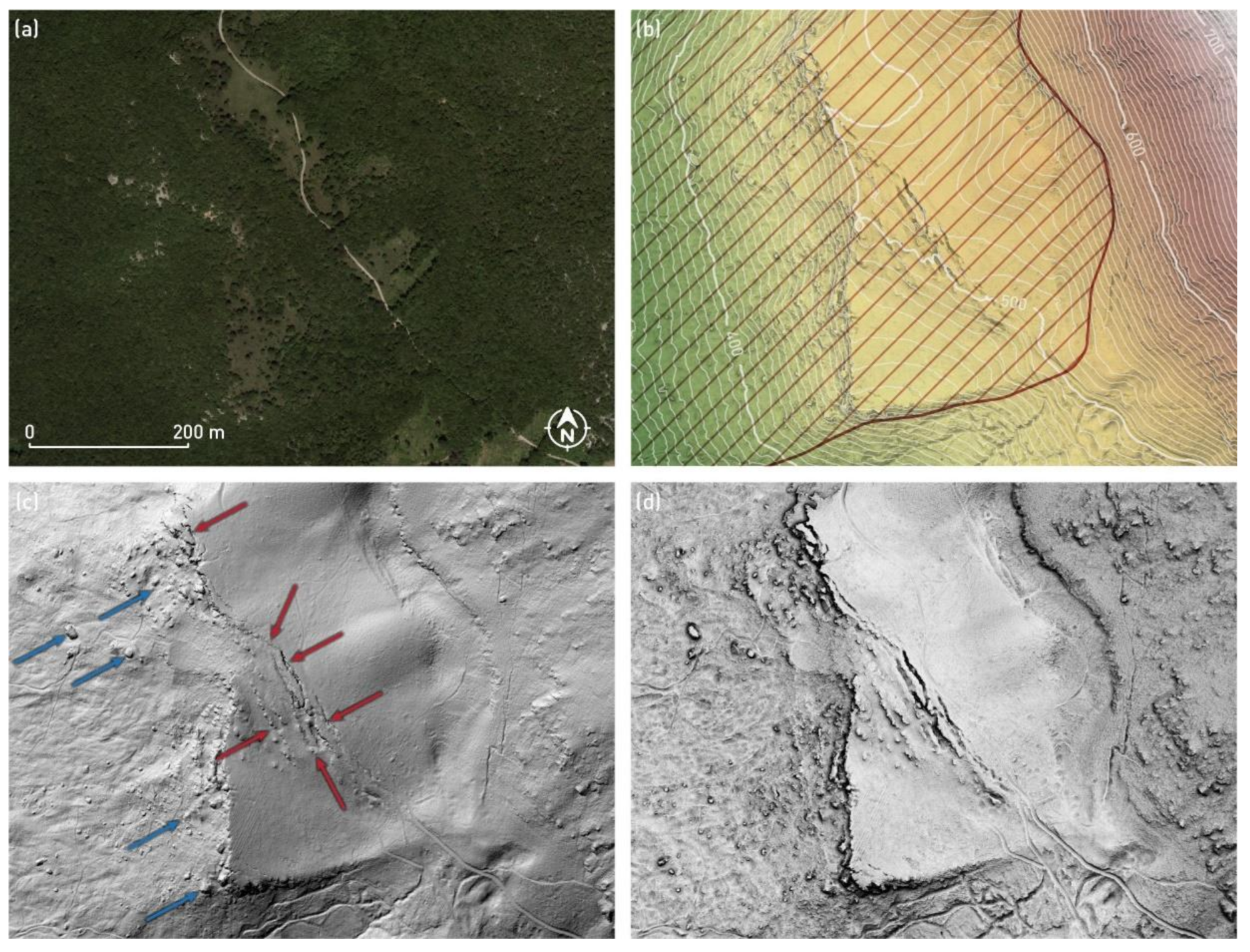
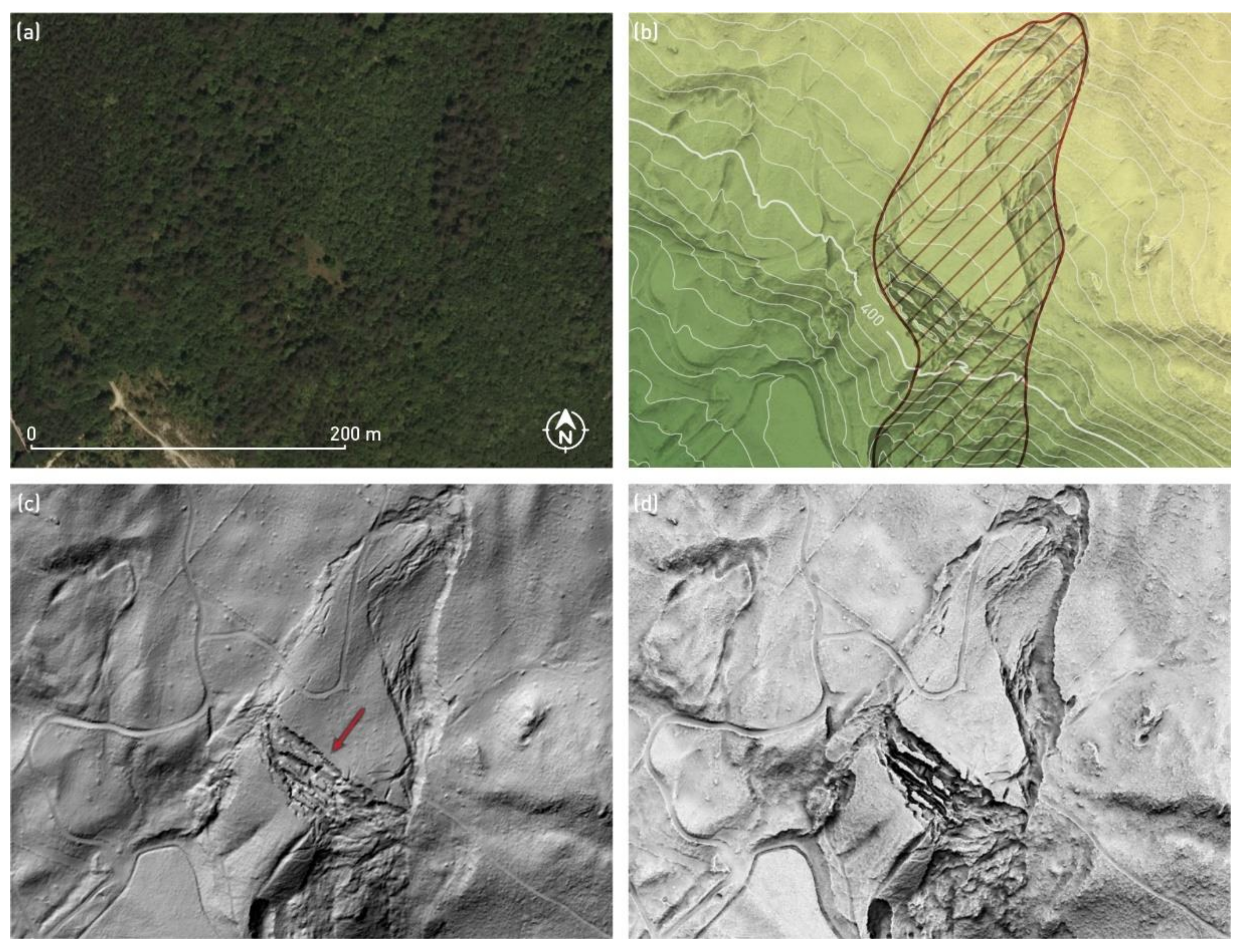

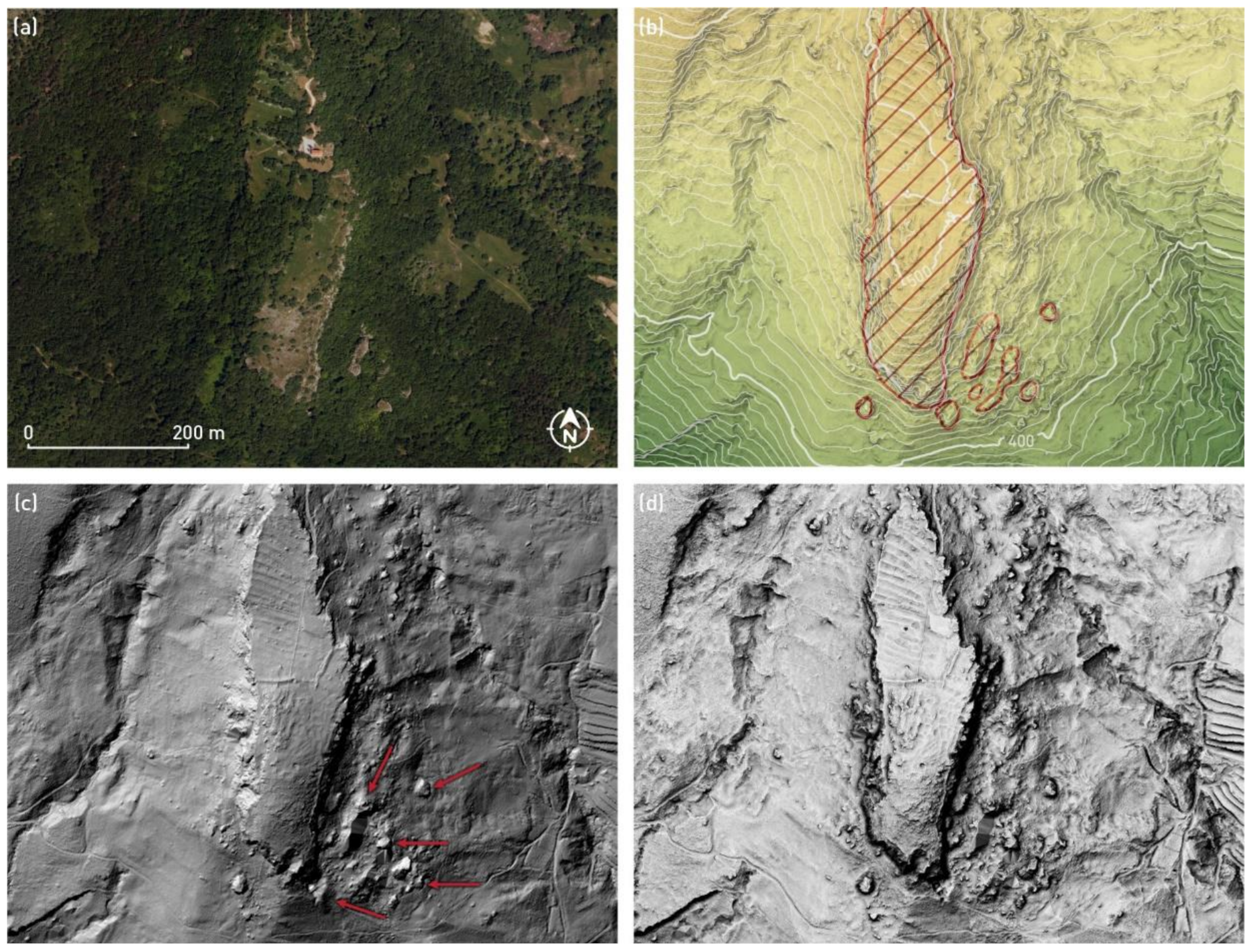
| Terrain Visualization | Computation Settings | Color Ramp/Band Combo | Histogram Stretch Type, min–max | Blending Mode and Opacity |
|---|---|---|---|---|
| VAT | ||||
| sky-view factor | radius 5 m, 16 directions | black to white | linear, 0.65–1.00 | multiply, 25% |
| positive openness | radius 5 m, 16 directions | black to white | linear, 68°–92° | overlay, 50% |
| slope | white to black | linear, 0°–55° | luminosity, 50% | |
| hillshading | angle 35°, azimuth 315° | black to white | linear, 0–100 | normal, 100% |
| RGB VAT | ||||
| sky-view factor | radius 5 m, 16 directions | black to white | linear, 0.65–1.00 | multiply, 25% |
| positive openness | radius 5 m, 16 directions | black to white | linear, 68°–92° | overlay, 50% |
| slope | white to black | linear, 0°–55° | luminosity, 50% | |
| hillshading from three directions | angle 35°, azimuth 315° | Red 315°, Green 22.5°, Blue 90° | linear, 0–100 | normal, 100% |
| Prismatic openness | ||||
| positive openness (Op) | radius 5 m, 16 directions | black to white | linear, 68°–92° | normal, 50% |
| negative openness (On) | radius 5 m, 16 directions | white to black | linear, 68°–92° | normal, 50% |
| hillshading from three directions | vertical exaggeration 3, angle 35°, azimuth 315° | Red 315°, Green 22.5°, Blue 90° | linear, 0–100 | normal, 100% |
| Red relief image map | ||||
| slope | white to red | linear, 0°–55° | normal, 50% | |
| (Op–On)/2 | radius 5 m, 16 directions | black to white | linear, −15°–15° | normal, 100% |
© 2019 by the authors. Licensee MDPI, Basel, Switzerland. This article is an open access article distributed under the terms and conditions of the Creative Commons Attribution (CC BY) license (http://creativecommons.org/licenses/by/4.0/).
Share and Cite
Verbovšek, T.; Popit, T.; Kokalj, Ž. VAT Method for Visualization of Mass Movement Features: An Alternative to Hillshaded DEM. Remote Sens. 2019, 11, 2946. https://doi.org/10.3390/rs11242946
Verbovšek T, Popit T, Kokalj Ž. VAT Method for Visualization of Mass Movement Features: An Alternative to Hillshaded DEM. Remote Sensing. 2019; 11(24):2946. https://doi.org/10.3390/rs11242946
Chicago/Turabian StyleVerbovšek, Timotej, Tomislav Popit, and Žiga Kokalj. 2019. "VAT Method for Visualization of Mass Movement Features: An Alternative to Hillshaded DEM" Remote Sensing 11, no. 24: 2946. https://doi.org/10.3390/rs11242946
APA StyleVerbovšek, T., Popit, T., & Kokalj, Ž. (2019). VAT Method for Visualization of Mass Movement Features: An Alternative to Hillshaded DEM. Remote Sensing, 11(24), 2946. https://doi.org/10.3390/rs11242946




